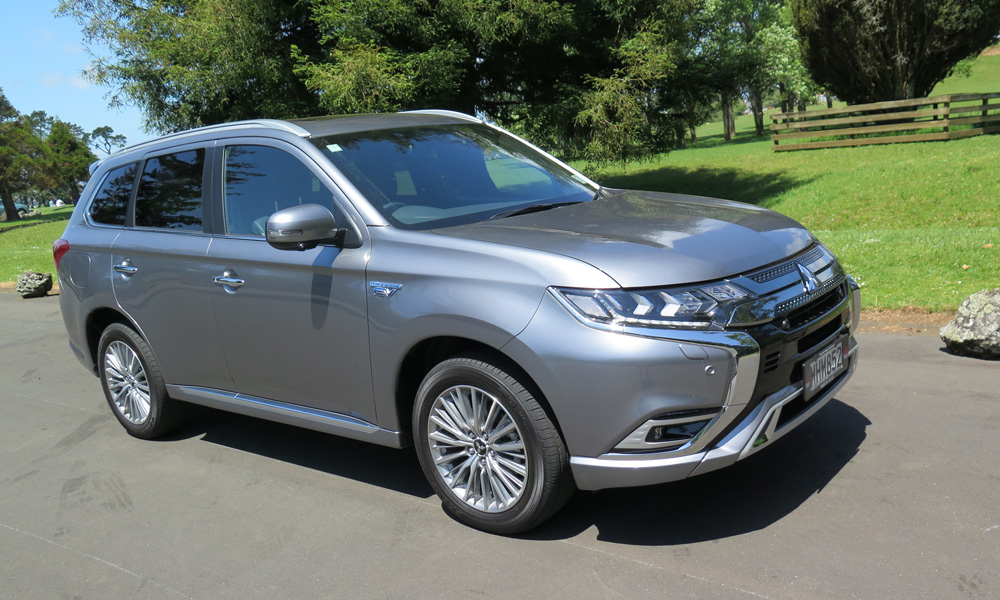
Mitsubishi Outlander PHEV 2022 car review
New Zealand’s 2021 top-selling passenger car has been joined by a new and improved plug-in hybrid electric cousin – the Next Generation Outlander PHEV.
02 December 2019
You’ll meet plenty of people who won’t buy an electric car, and wouldn’t consider a plug-in hybrid because the tech 'isn’t yet perfect'.

This could be because batteries improve all the time, they worry that materials are scarce, or that battery recycling isn’t sorted yet. But let’s face it, if you never bought anything that smacked of modern tech unless it was perfect, you wouldn’t have any car, any TV, any cell phone – because they continue to get better. None of it is perfect at this precise moment, even at the priciest end of the market. If it was, businesses would go bust right and left, for no one would ever need to replace anything.
Any purchase is a compromise between the best you can get to fulfill your wants and desires, at the amount you can afford to pay.
And with that out of the way, let’s just say that a plug-in hybrid could be the best compromise between the internal combustion engine and the new wave of propulsion methods that avoid burning fossil fuels as much as possible.
Petrol is pricey, diesel isn’t exactly free, and so far electricity brings range concerns, if not during the daily commute, certainly the moment you want to go on holiday without planning your trip entirely around the growing – but still sparse in places – network of high-speed charging devices.
Hybrids have gained increasing acceptance, but they are at their best round town and still use petrol, especially during open-road driving.
Hence plug-in hybrids, of which this latest version of Mitsubishi’s Outlander PHEV is one.
A plug-in hybrid is almost a cross between a hybrid and an electric car. It has both a petrol engine and an electric one. You plug into a socket – a household one will do as though recharge is slower, the battery tops out with around a 50km range, so it’ll more than fill overnight. That means most folk can do the daily work or school run purely on electricity, without stopping at the pump, or emitting anything nasty from the car’s tailpipe. Silent running too, so those early starts or late finishes will no longer annoy the neighbours along your shared driveway.
If you need to go further than 50km between stops at a socket, the car simply runs as a hybrid – using less petrol if you’re round town and braking or decelerating a lot (both of which regenerate power) – and using more petrol on the open road, the overall equation still saving you money at the pump.
Do enough distance, and the private buyer will save the premium paid on purchase well before selling it.
At least, judging by our stint with this car. Outlander is not new, and nor is the PHEV version, but this year brings more small improvements. The petrol motor grows to 2.4 litres, with a whisker more power – combined output is up to 130kW – while the battery extends possible range, now up to 55km (depending on how and where you drive). There’s also a new Sport driving mode, which along with the power boost is designed to improve mid-range grunt, something we noticed on our hilly test route. Or rather, this time around we didn’t notice power flagging at times, in normal traffic – whether highway, round town or over hilly swervery – the Outlander always felt as if it had something in reserve.
It also has something in reserve come winter, with a new ‘Snow’ mode which, given it’s spring in Auckland as we tested the car, we had to take on trust. Otherwise the car distributes torque to whichever wheel has grip, while lock is available for rough roads, sand or snow. Our steep gravel driveway, taken almost from rest, didn’t cause even a moment’s hesitation or slip.
The PHEV comes in two spec versions, the XLS at $52,900 and the VRX at $57,990. That’s 12K more than the standard petrol equivalents.
Both versions have heated seats – if you want to save power, you’ll warm up quicker and more efficiently with a warm butt than by heating the entire cabin.
As long as you remember to plug it in – we twice forgot overnight – you can save a lot of money on petrol. Our tester has a 45km commute each way, and thus halved petrol use, at least, with the daily average never topping 3.5l/100km, not bad for a five-seat SUV. Had there been a socket near that daytime car park, it would have been less. You can charge the battery to 80% in 20 minutes, overnight more than does the rest, taking 6.5 hours to from zero charge in the battery to full.
When our tester collected the car, it showed EV range of around 49km, having been driven a bit already. Forty kilometres later it was parked for the night – having used not a scrap of petrol – but it then wasn’t plugged in.
The next two days saw a variety of errands conducted without an overnight charge, and with simple odd top-ups from the household socket here and there. The car was effectively running as a hybrid, regenerating power on braking and downhills offsetting petrol use elsewhere.
After a full overnight charge we drove around 50km on electric only before running out of battery power, despite having the air con working hard on a 25-degree day. At day’s end, and after quite a few more errands in round-town traffic, the PHEV had averaged 1.8l/100km.
The standard petrol-fuelled Outlander 2.4 4WD VRX retails at $45,990. The equivalent PHEV, as tested, asks a 12k premium. Only you, dear reader, know how far you drive each week, and can therefore calculate the effects on fuel costs – bearing in mind a daily round-trip commute or school run that totals less than 50km would cost nothing at the pump for the PHEV – and how long it would take before your fuel savings would offset the premium, quite apart from any considerations around reduced noise and tailpipe emissions.
Our tester’s very rough and admittedly unscientific calculation based on their own driving habits showed a premium paid off in around five years. Try it with your family, and see.
Now add to petrol savings the fact you’re obtaining them in a spacious, nicely-specced all-rounder that fits five and luggage in comfort, and you realize that this Outlander should be on any family SUV buyer’s shortlist of purchase options.
| At a glance | |
|---|---|
| Models | Mitsubishi Outlander PHEV VRX S-AWC |
| Engine | 2.4-litre petrol engine with 13.8kW/h battery |
| Price | $57,990 |
| ANCAP safety rating | 5 |
| Power and Torque | Electric motor 60kW front, 70kW rear, petrol engine 94kW. Max torque 332Nm, or 199Nm at 4500rpm |
| Transmission | Auto |
| Fuel economy | 1.9l/100km |
| Towing capacity | 1,000kg |
| 2WD/4WD/AWD | AWD |
| Seating capacity | 5 |
| Luggage capacity/payload | 886 litres, second row seats folded |
